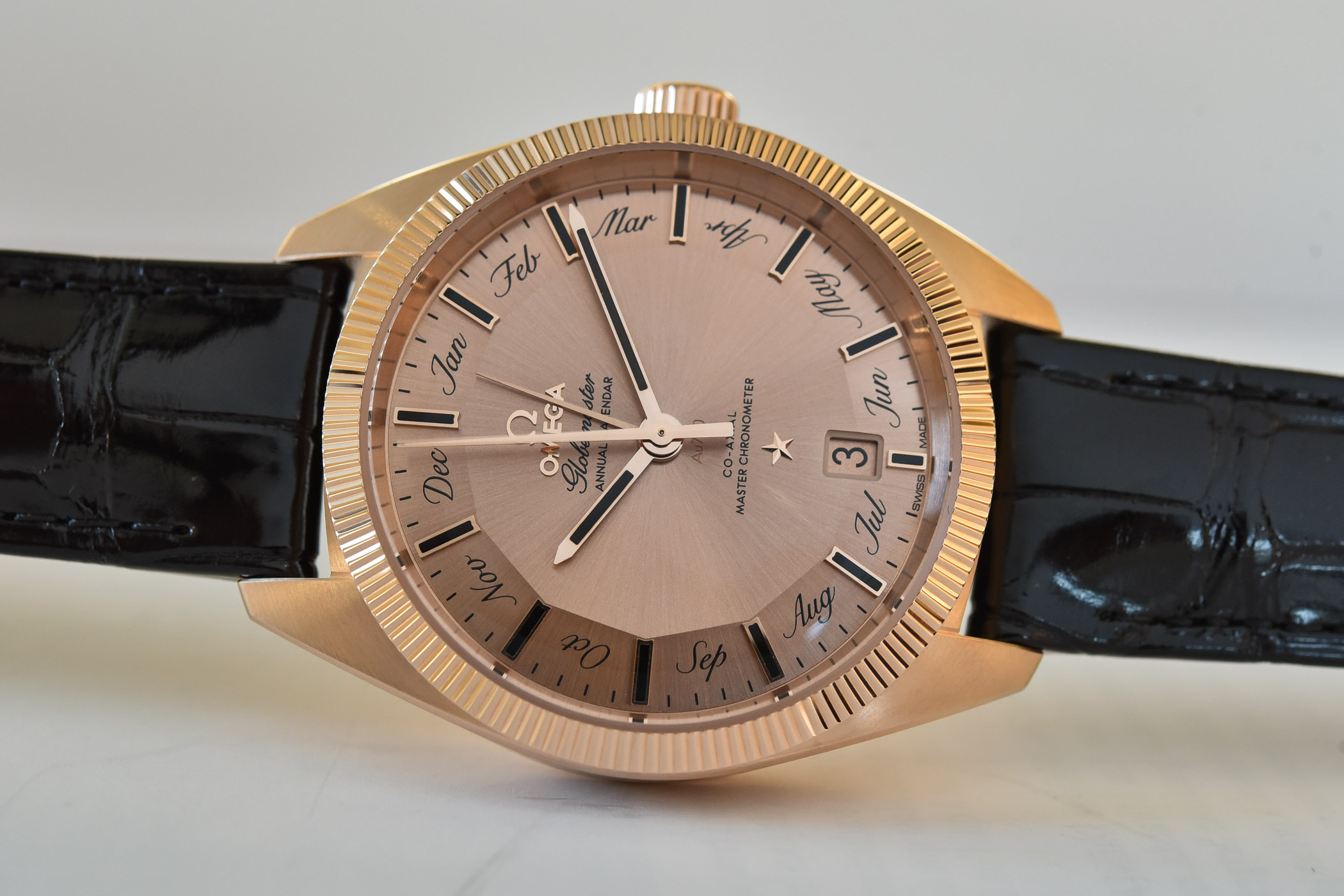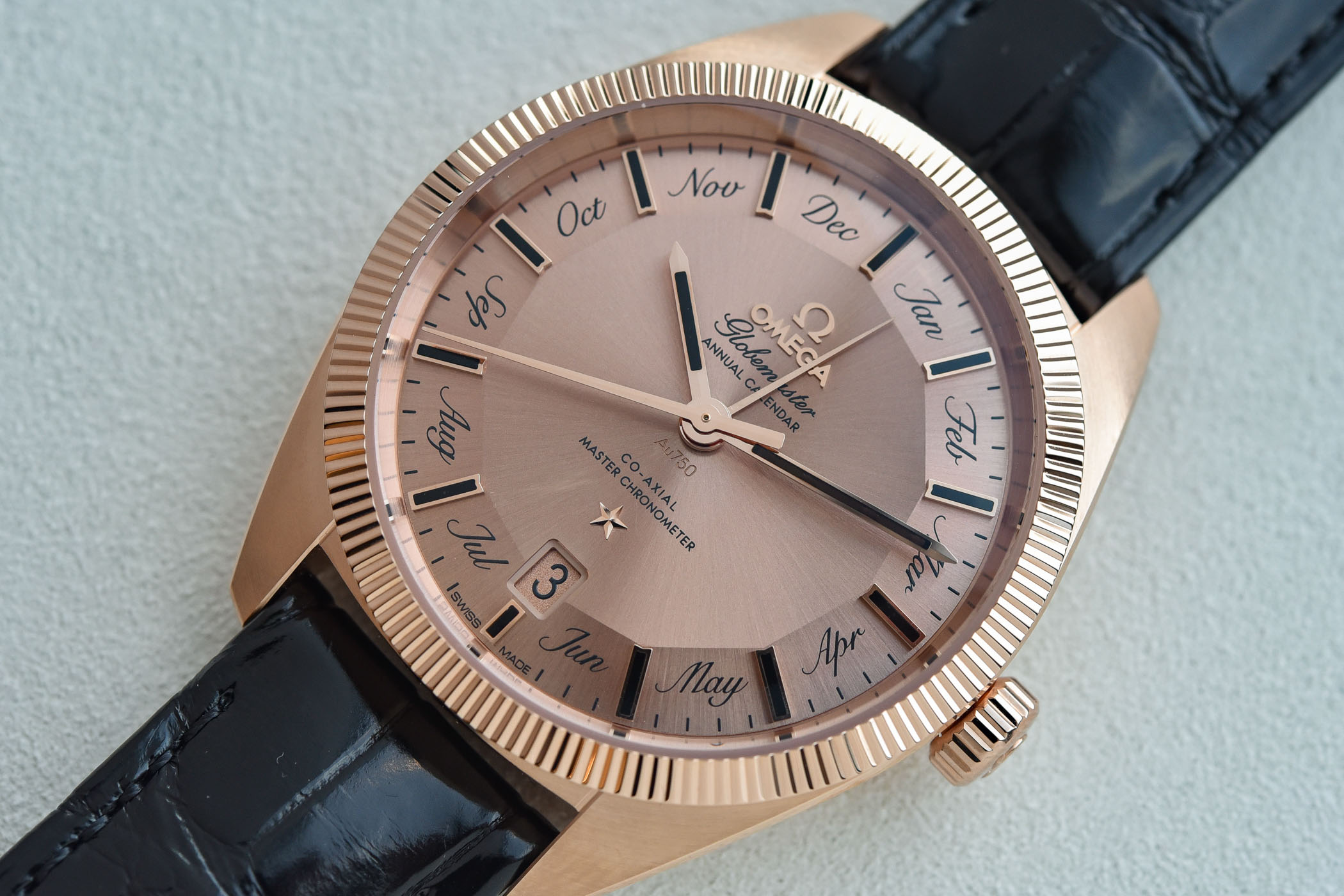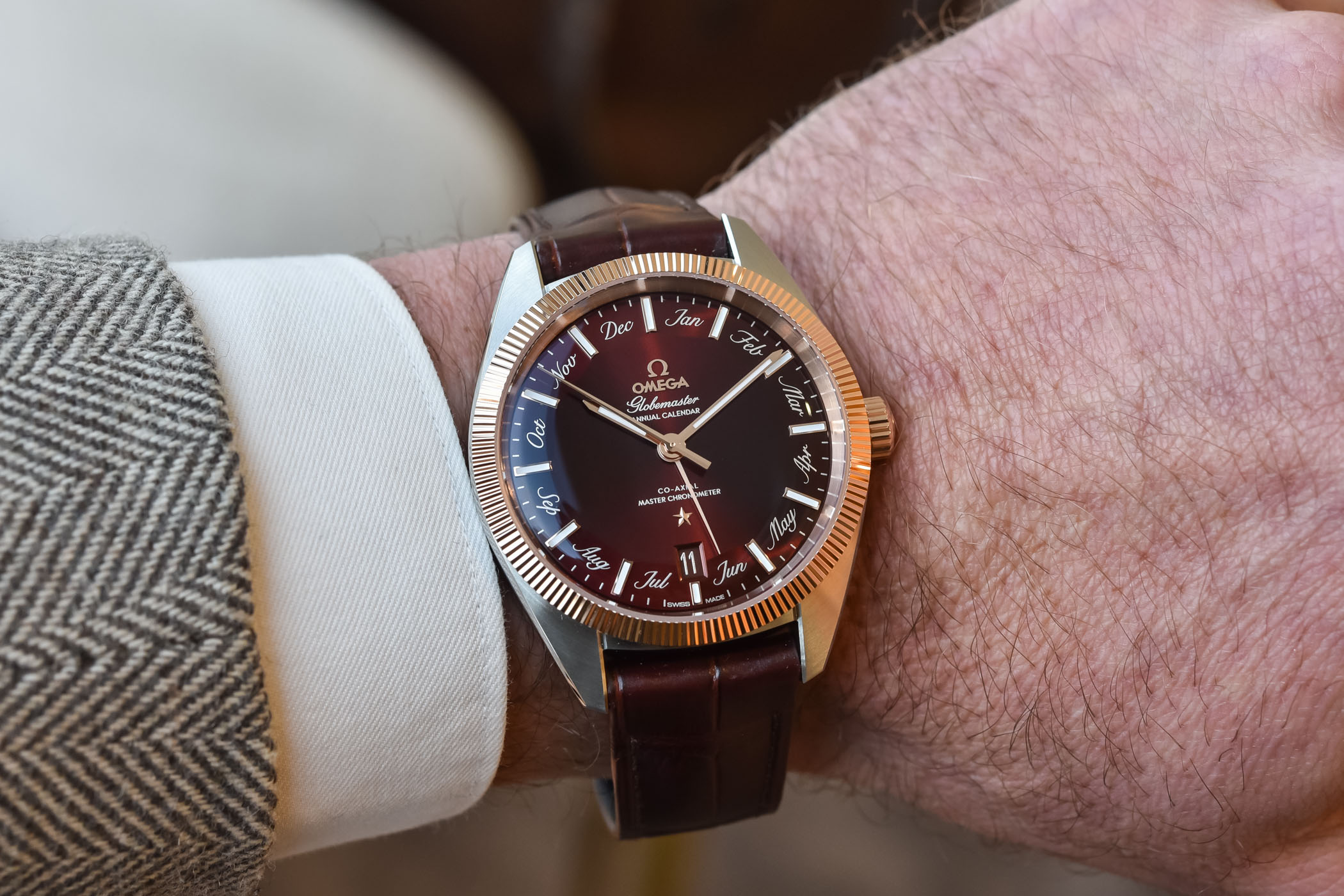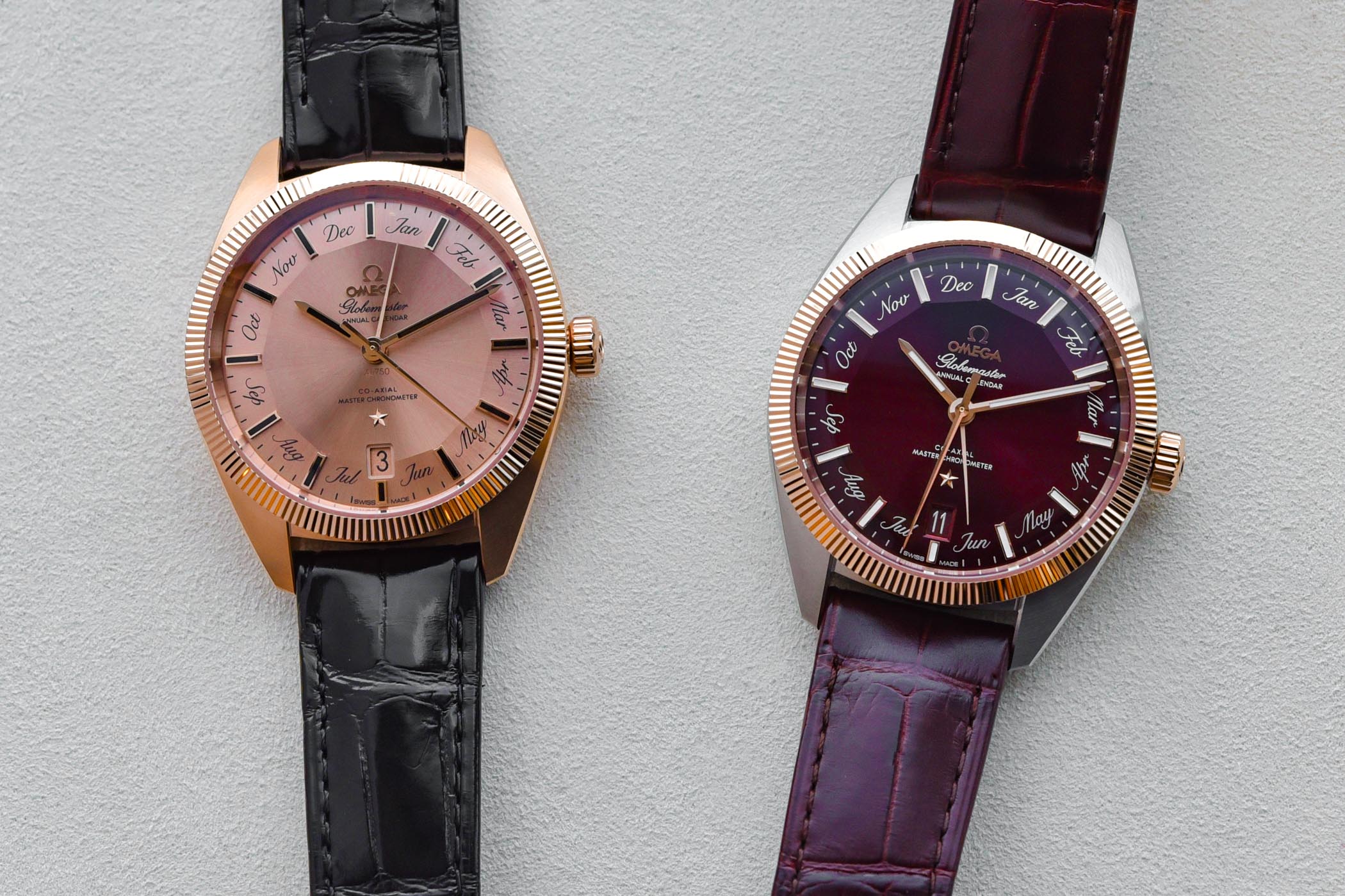The New Editions of the Omega Globemaster Annual Calendar
Getting our hands on the latest additions to the Omega Globemaster collection.

Omega is primarily known for two significant and historic collections: the Speedmaster and the Seamaster. For more than half a century, these two models have dominated the show at the Biel-based brand, giving it its iconic status. But, Omega has much more to offer than these two sports watches. In fact, there’s a collection that is even more enduring, and that is the Constellation. Built as a more elegant and more refined range of models, it even includes a pretty complex and satisfying calendar watch, the Globemaster Annual Calendar. Three new editions have been launched a couple of weeks ago, and today we have a look at two of these new, luxurious and colourful additions to the Globemaster lineup.
Although the aura of the Speed- and Seamaster collections is unbeatable, there’s one collection at Omega that is even more enduring, and that is the Constellation. Born in the late 1940s, way before the two other sports collections were even imagined, the Constellation was the expression of Omega’s wish for precision and mechanical refinement, as attested by the presence on the casebacks of a medallion featuring the Observatory of Geneva crowned by a constellation of eight stars. Launched as a dress watch with ultra-precise movements, the collection gained popularity in the early 1950s with the introduction of the so-called pie-pan dials, a distinctive and emblematic element of the collection. By the mid-1960s, the Constellation changed drastically, going for integrated designs and quartz movements, eventually giving rise to the Constellation Manhattan family. You can read our in-depth historical article here for more details on the evolution of the Omega Constellation.
After some years in the background, the watch returned to its original concept in 2015 with the launch of the Globemaster sub-collection – a watch that was, by design and vocation, a solid tribute to the original Constellation concept, as it was also the watch to house the brand new Master Chronometer certification. Initially presented in 2015 as a time-and-date watch, with an hour hand that can be set independently, the following year, the brand launched a model with a highly interesting annual calendar complication. Today, the Constellation family pays tribute to these two sides of the history of the collection, with watches displaying integrated designs and these ultra-precise, complex and luxurious Globemaster models.
The Globemaster Annual Calendar is, with the Seamaster Aqua Terra Worldtimer, one of the most complex models in Omega’s collection – with the exception of the high-end Tourbillon watch. Omega, just like Rolex, isn’t a brand that does haute complication watches just for the sake of demonstrating its superiority. Knowing the strength of its R&D department, Omega could easily build far more complex models, but that isn’t its vocation. This explains why, for its Globemaster collection, the brand went for an annual calendar rather than a perpetual calendar. One of the most practical complications of the industry, as it only requires one correction a year for the calendar indication and is not overly complex, it’s also much easier to use and more reliable.
The whole concept behind the Annual Calendar complication, an invention of Patek Philippe in 1996, is to offer an intermediate solution between the too simple and not very practical full calendar (requiring five corrections a year) and the overly complex, often fragile perpetual calendar. An annual calendar only requires to be adjusted at the end of February, as it takes into account months with 30 or 31 days. And that can be achieved with minimal modifications compared to a traditional complete calendar.
As mentioned, the Globemaster is the closest modern expression of the original Constellation concept. As such, it was launched as a watch focused on precision and displayed multiple design elements that pay tribute to the early-1950s models, including the pie-pan dials or the medallion on the caseback. Yet, when the brand presented the Globemaster Annual Calendar, it made a strong impression, primarily due to the surprising month inscriptions on the dial, which after some years have finally been well accepted.
This year, and without much changing the original recipe of the initial Globemaster Annual Calendar, Omega introduced three new versions. Colourful and/or made of luxurious materials, these add a fresh, slightly bolder but also pleasant look to this collection. First is a steel version with green dial (not photographed here), then there is a two-tone model with a steel case, 18k Sedna gold bezel and crown and a daring burgundy dial and strap – a combination that truly works in the metal, with charm and warmth, even though it won’t be for everyone.
The last of these three new models is entirely made of 18k Sedna gold, which includes the dial, the hands, and the applied markers. It is worn on a shiny alligator strap. At first, you could imagine this combination to be slightly over the top, but, actually, when handling and strapping the watch on, it is far more subtle than expected. Sure, it’s a full gold watch, but due to the relatively muted tone of Sedna gold, to the use of brushed surfaces almost everywhere (on the case and the dial), this edition of the Globemaster Annual Calendar brings a luxurious but not ostentatious look with multiple reflections, depth and changing colours in a pleasant dégradé of pink gold tones.
For the rest, these new editions remain identical to the previous versions. They measure 41mm in diameter and 14.5mm in height, the latter being a bit too pronounced for our taste. With its straight lines, its combination of brushed surfaces with a polished and fluted bezel, and a certain heft, the watch is elegant without being too formal. The dial has the typical pie-pan design, which has been cleverly used to display the month indication. One specificity of the gold edition, besides having a solid gold dial, is to feature black onyx inserts for the applied indexes, and for the first time, also for the hours and minutes hands.
Turning the watch over, we can see the calibre 8922 or 8923 (the latter used for the gold model, with a gold bridge and rotor). Mechanically identical, we’re talking about in-house automatic Master-Chronometer engines with all of the brand’s technology: anti-magnetic silicon parts, double barrel, Co-Axial escapement. The movement is partially visible under a sapphire caseback, with the emblematic medallion featuring the Observatory of Geneva.
Availability & Price
These three new editions of the Omega Globemaster Annual Calendar are released as part of the permanent collection and are now available for orders. The steel-green model (130.33.41.22.10.001) retails for EUR 8,300, the two-tone burgundy version (130.23.41.22.11.001) for EUR 11,100 and the full Sedna gold version (130.53.41.22.99.002) for EUR 30,600.
For more details, please visit omegawatches.com.











3 responses
Thank you for the brief but (as usual) very good write up on the new Globemaster Annual Calendar (GMAC). It is good to see that you actually had some real watches to review because as you will no doubt be aware the last variation of the GMAC, a glossy black dialed version from 2019, never seemed to get delivered to the public. I would very much like to have seen how the green dial stainless steel model looked in real life as Omega is notorious for publicity photographs that are far too “processed” and so one can never be sure how a particular dial colour will actually look. One slight error in the introduction to the article as to how the Constellation range was introduced – the Constellation range was actually introduced in 1952, rather than the late forties, following the success of the Centenary Watch of 1948 which prefigured the design of the later Constellations. The success of the Centenary Watch ensured that all Constellations would be official chronometers, which was quite unusual for the time. Of course the first Omega “family” of watches, the Seamaster was first introduced in 1948 with some models being official chronometers but most were not, and this trend continued with the Seamaster range for most of the the fifties. Hence the real achievement of the Constellation range in being the second Omega watch “family” but making sure all the watches were as precise as they could be.
Must say I like the watch with the dark red dial.
Big fan of Omega in general.
Quite stunning. Sedna gold release is as exquisite a piece as can be had in the price point. Pure class. Remarkable charm. Thanks for a delightful read.